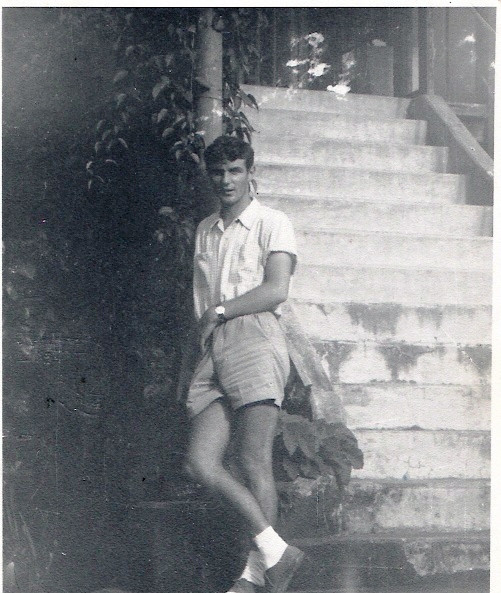by Larry Brown
An earthquake gets nearly everyone’s attention, particularly if it is a severe one. The damage is spectacular and the event is meticulously recorded by seismologists and news coverage is given throughout the media.
In a big earthquake, seemingly sturdy buildings and bridges collapse, roads subside , houses are razed, landslides occur and there can be a tragic loss of life.
Such an earthquake can be preceded by a roar that is like a hundred locomotives and as it approaches the ground undulates alarmingly, fissures appear, bushes and shrubs shudder and tall trees bend back and forth - all in all, a scary scenario. Planters who went to New Guinea after India experienced many earthquakes and volcanic eruptions particularly in East and West New Britain where there were many active volcanoes.
The tea districts in Assam have had their fair share of earthquakes too and perhaps the biggest that some planters remember is the one that happened in 1950. This earthquake wreaked havoc in Assam; huge landslides caused rivers to change course, rail lines were twisted into all shapes, bridges disappeared, roads became impassable and many tea factories were rendered inoperable.
It cannot be said that the same interest or attention is given to the
floods that happen almost every year
As mentioned, great attention and focus is given to a big earthquake and its aftermath and possibly this is because the tremors travel a long way from the epicentre and can be felt in large cities and this, therefore, elicits more interest.
 |
| The Teesta River near Gangtok. All pix by the author |
It cannot be said that the same interest or attention is given to the floods that happen almost every year sometimes with a great loss of life. Of the 50 or so major rivers in India at least 18 are flood prone and can cause major damage to infrastructure, loss of crops and livestock, and tragically, human suffering and loss of life - and yet, some are miraculously spared, and this is my story.
The Teesta rises at 17,500 ft at the Cho Lhamu Lake in the Himalayas and winds its way through Sikkim ,down the Teesta valley, passing near Kalimpong and on to the plains of West Bengal at Sevoke. It passes many large villages and towns such as Jalpaiguri on its banks and flows on through Bangladesh before finally discharging into the great Brahmaputra.
I first saw the Teesta from the Coronation Bridge, an impressive structure which spanned the river on the road to Siliguri and Kalimpong. From the bridge, some hundreds of feet below, the river was a swirling mass of turbulent white water. An accompanying planter friend said it had the reputation of being an 'evil' river and this may have had its origins in a tragedy that happened in one of the early surveys in 1915 when G.P.Robertson, the Municipal Engineer of Darjeeling, was drowned after losing control of his boat in the turbulence. The boat struck a submerged boulder and was sucked into a whirlpool, leaving no trace of Robertson or his companions.
I can recall the year of the lucky escape, 1968, but not the exact month but I remember the events well.
Myself and my wife went to Mal Junction in the Dooars in the evening to see a Hindi movie. It was raining as we set out from Bhogotpore and was fairly heavy by the time we reached Mal.
Shortly after the picture began we could hear the rain drumming on the roof and this steadily got heavier until it was almost impossible the hear the film dialogue – or the songs!
The film show was stopped and we exited the hall, hoisted the umbrellas and dashed to the car. The water around the car was ankle deep.
I had never witnessed rain like this before and as we made our way towards Chulsa, visibility decreased and we got slower and slower as the rain became heavier and heavier. When we turned into the Jaldhaka/Nagrakata road that would take us home to Bhogotpore, we were down to first gear and the wipers were on full speed. As we cautiously followed the black ribbon of the road we passed through the Chapramari Reserve Forest and had to gently nudge our way through herds of deer and other animals that were milling around in confusion.The road was much higher than the now flooded reserve forest and we encountered other groups of animals as we proceeded further. In one group two pairs of yellow eyes amongst the deer looked at us, two magnificent leopards, their coats sodden and bedragggled, just as scared and confused as their companions.
On the relatively short distance through the forest new reinforced concrete bridges spanned the rivers. These stood out stark and white and the black ribbon of road that we were following led on to them. When we crossed the by now raging Jaldhaka river we were almost home.
The rain pelted down all night and only ceased in the early morning hours.
So where's the lucky escape?
Next morning I went to see how widespread the flooding was and as I approached the Jaldhaka bridge I could see that some temporary barriers had been erected. I walked on the bridge and looked downstream and there I could see a number of scattered vehicles that were partially submerged. I counted two buses, a jeep and at least five cars. There were more much further downstream. All the vehicles were found to be empty, there were no survivors.
When I got to the other side of the bridge I saw that at least 40 to 50 ft of the approach road had been washed away resulting in a long drop to the river below. The poor unfortunates from the vehicles I had just seen would have been doing the same as I had done - following the black ribbon - but for them, that ribbon concealed a gaping chasm.
When the approach was washed away I have never found out. It could have been minutes after we passed safely or an hour but certainly not longer than that.
Later, when piecing together what had happened I found that the downpour had set in motion a chain of events that was to prove catastrophic.
This torrential rain (at its peak someone told me that 14ins was recorded in a few hours) had caused massive landslides in the deforested hill areas near Kalimpong and these blocked the river forming a natural earth dam hundreds of feet high. The Teesta backed up for miles, and then, at about two in the morning, the dam gave way. The railway bridge further down from the Coronation Bridge was swept away.
The massive wall of water, travelling like an express train, reached Jalpaiguri at about 2.30am. It was reported that water levels in the town rose by 10ft in three minutes. Jalpaiguri was almost totally flattened. The waters careened on downstream causing further devastation and taking out whole villages along the way. The destructive run continued through the Rangpur district of Bangladesh before finally discharging into the Brahmaputra at Fulcherry.
A few days later the 'Statesman' had the headline '2000 feared dead'. This was amended in the next edition to '5,000 feared dead'.
Coco Das, a burly bearded planter, was engaged in relief operations along with many others in the district. Because of the stench of death and decay, he had doused his beard with after shave lotion. He and some of his fellow relief workers who knew also about the Teesta told me that the figure of those lost would be closer to 100,000, but the real figure will never be known.
Since that great flood, spurs have been built at Jalpaiguri so that the 1968 catastrophe would not be repeated.
We had a very lucky escape indeed.
 |
| This is the bridge over the Jaldakha in the 2019 “Siliguri Times” noted as neeing repair |
Footnote:
See Minoo Avari’s story “Darjeeling October 1968” under Correspondents on the www.koi-hai site. He and his friend crossed the ‘Anderson Bridge’ at Kalimpong literally seconds before it was washed away!
There were TWO Lucky Escapes that night!!
Meet the writer:
Larry Brown lives in Southport, Queensland, Australia. His story The Ghost of Namdang Factory Bungalow is a great favourtie with our readers. Here are two pictures of Larry - one from 1960, and the other from 2014 when he revisited Namdang.
 |
| At Namdang Factory Bungalow steps, 1960 | |
|
 |
Larry revisits Namdang, 2014
|
Is this your first visit here? Welcome to Indian Chai Stories!
Do you have a chai story of your own to share? Send it to me here, please : indianchaistories@gmail.com. My name is Gowri Mohanakrishnan and I'm a tea planter's wife. I started this blog because one of the things that I wouldn't want us to lose in a fast changing world is the tea story - a story always told with great seriousness, no matter how funny - always true (always), maybe a tall tale, long, or short, impossible, scary, funny or exciting but never dull. You will find yourself transported to another world!
Happy reading! Cheers to the spirit of Indian Tea!
ADD THIS LINK TO YOUR FAVOURITES :
https://teastorytellers.blogspot.com/




















